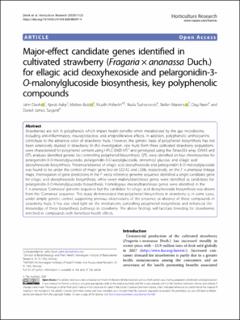| dc.description.abstract | Strawberries are rich in polyphenols which impart health benefits when metabolized by the gut microbiome, including anti-inflammatory, neuroprotective, and antiproliferative effects. In addition, polyphenolic anthocyanins contribute to the attractive color of strawberry fruits. However, the genetic basis of polyphenol biosynthesis has not been extensively studied in strawberry. In this investigation, ripe fruits from three cultivated strawberry populations were characterized for polyphenol content using HPLC-DAD-MSn and genotyped using the iStraw35k array. GWAS and QTL analyses identified genetic loci controlling polyphenol biosynthesis. QTL were identified on four chromosomes for pelargonidin-3-O-malonylglucoside, pelargonidin-3-O-acetylglucoside, cinnamoyl glucose, and ellagic acid deoxyhexoside biosynthesis. Presence/absence of ellagic acid deoxyhexoside and pelargonidin-3-O-malonylglucoside was found to be under the control of major gene loci on LG1X2 and LG6b, respectively, on the F. × ananassa linkage maps. Interrogation of gene predictions in the F. vesca reference genome sequence identified a single candidate gene for ellagic acid deoxyhexoside biosynthesis, while seven malonyltransferase genes were identified as candidates for pelargonidin-3-O-malonylglucoside biosynthesis. Homologous malonyltransferase genes were identified in the F. × ananassa ‘Camarosa’ genome sequence but the candidate for ellagic acid deoxyhexoside biosynthesis was absent from the ‘Camarosa’ sequence. This study demonstrated that polyphenol biosynthesis in strawberry is, in some cases,under simple genetic control, supporting previous observations of the presence or absence of these compounds in strawberry fruits. It has also shed light on the mechanisms controlling polyphenol biosynthesis and enhanced the knowledge of these biosynthesis pathways in strawberry. The above findings will facilitate breeding for strawberries enriched in compounds with beneficial health effects. | |
